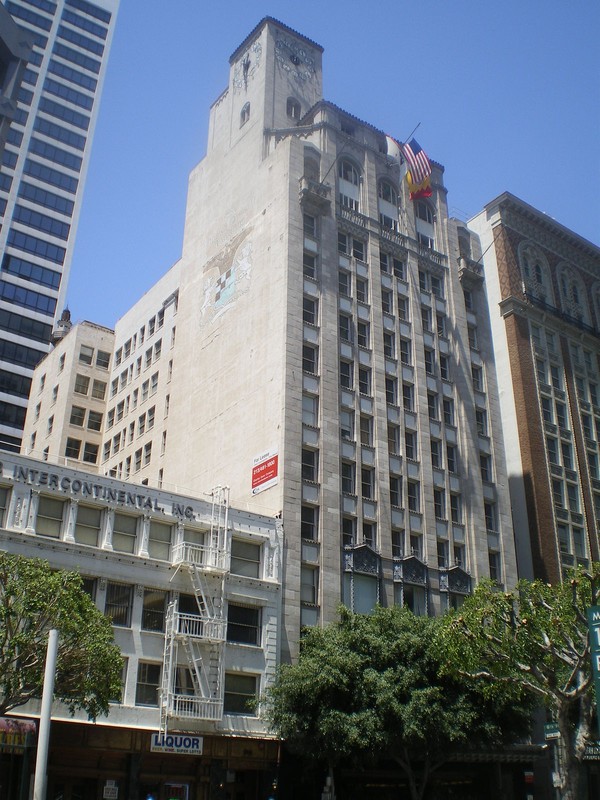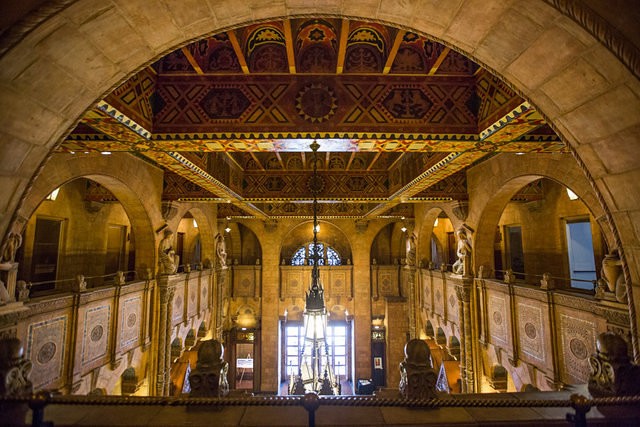Oviatt Building
Introduction
Text-to-speech Audio
Completed in 1928, this building acted as the headquarters of one of the most prestigious and expensive haberdasheries of the time, Alexander & Oviatt. The building housed their shop, which is now Cicada restaurant, rentable office space, and a penthouse suite for owner James Oviatt to live in. The building was designed in the Italian Romanesque style after Oviatt attended the 1925 Paris Exposition and was inspired by the architecture there. When the building was completed, the sheltered lobby forecourt contained over thirty tons of glass by designer Rene Lalique, and a few original panels remain to this day. The ten-room penthouse was originally decorated by the Parisian design firm of Saddler et fils and featured burled mahogany furniture and cabinets, parquet wood floors in geometric patterns, carved woodwork, imported fabrics and Lalique glass throughout. Oviatt enjoyed strong ties to people and groups that preached antisemitic and racist ideologies; the building eventually housed the Christian Defense League, which publicly promoted antisemitism and "America First" philosophies. Oviatt handed out materials to customers that promoted antisemitic beliefs, as well.
Images
The Oviatt Building in 2008

A shot of the interior from the lobby area.

Backstory and Context
Text-to-speech Audio
The James Oviatt Building, or Oviatt Building, gets its name from its original owner, James Zera Oviatt. In 1909, Oviatt moved to Los Angeles from Salt Lake City, where he was born in 1888. His first job involved working as a department store window dresser. But, in 1912, Mr. Oviatt partnered with a hat salesman, Frank Baird Alexander, and an architect Frank Shaver Allen (who acted as a silent partner due to a sex scandal), in launching a men's clothing business: Alexander & Oviatt haberdashery in downtown Los Angeles.
Oviatt regularly traveled to Europe where he discovered stylish clothing and trends, which he brought back to his Los Angeles haberdashery. The store's success eventually led to the decision to build the now-historic structure. In designing the historic Mr. Oviatt sought to create a building that celebrated Art Deco, which had grown popular in France and the U.S. during the 1920s. The Oviatt Building opened in 1928 with luxurious furnishings, including a twelve-ton illuminated glass cornice and glass arcade ceiling. Oviatt also had a lavish, ten-room penthouse designed for his personal use in the new structure. The building embodied the Art Deco style and the enthusiasm associated with the "Roaring '20s."
However, while Oviatt gained notoriety for his store and Art Deco building, he was also a member and ardent supporter of the far-right John Birch Society and enjoyed strong ties to Rev. Wesley A. Swift, whose speeches and sermons included antisemitic ideology. Swift was also a prominent figure in the California Ku Klux Klan. Meanwhile, Oviatt provided his customers copies of antisemitic and racist publications such as The Protocols of the Elders of Zion and Common Sense. Oviatt and Swift also enjoyed a friendly relationship with Gerald L.K. Smith, a minister, white supremacist, and American nationalist. Smith created the Christian Nationalist Party and Christian Defense League, which Swift managed for a time in offices within the Oviatt building.
Today, most of what is remembered regarding the Oviatt building is its Art Deco style and its association with 1920s culture, as noted by a 2008 documentary on the building directed by Seth Shulman and written/produced by Marc Chevalier in 2008. Today, the historic building is home to the Cicada Restaurant, which proudly notes its association with the landmark Art Deco building; the restaurant operates as a 1920s-themed lounge. Indeed, the building has been designated as a Los Angeles Historic-Cultural Monument because of its style and the era with which it's associated.
Cite This Entry
Middleton, Chris and Mathew Powers. "Oviatt Building." Clio: Your Guide to History. October 27, 2022. Accessed April 26, 2025. https://theclio.com/tour/301/11
Sources
Bochicchio, A. "Justification by Race: Wesley Swift's White Supremacy and Anti-Semitic Theological Views in His Christian Identity Sermons." Journal of Hate Studies, 17, no 1 (2021), 35–51.
Harnisch, Larry. "Forgotten by time, but not out of style. LA Times." August 09, 2012. Accessed July 30, 2017. http://articles.latimes.com/2012/aug/09/local/la-me-harnisch-chevalier-20120809.
"James Oviatt Building BEST ART DECO (1928)." LA Weekly. Accessed July 30, 2017. http://www.laweekly.com/best-of/2010/people-and-places/best-art-deco-1928-2202402.
Jeansonne, Glen. Gerald L. K. Smith: Minister of Hate. Baton Rouge: LSU Press, 1997.
--- --- ---. "Preacher, Populist, Propagandist: The Early Career of Gerald L. K. Smith." Biography 2, no. 4 (1979): 303–27. http://www.jstor.org/stable/23539142.
Meares, Hadley. "The James Oviatt Building: The Bespoke Brilliance and Pretension Behind an Art Deco Masterpiece." Public Media Group of Southern California: KCET.org. History & Society sec. September 6, 2013. https://www.kcet.org/history-society/the-james-oviatt-building-the-bespoke-brilliance-and-pretension-behind-an-art-deco-masterpiece.
"No. 195 - Oviatt Building. Big Orange Landmarks." November 01, 2008. Accessed July 30, 2017. http://bigorangelandmarks.blogspot.co.uk/2008/11/no-195-oviatt-building.html.
"Oviatt Building." LA Conservancy. Accessed July 30, 2017. https://www.laconservancy.org/locations/oviatt-building.
"RIGHTIST MAILINGS STIR COAST CLASH; Merchant Threatens Suit on Anti‐Semitism Charges." New York Times. February 9, 1964. https://www.nytimes.com/1964/02/09/archives/rightist-mailings-stir-coast-clash-merchant-threatens-suit-on.html.
By Los Angeles - Own work, CC BY-SA 3.0, https://commons.wikimedia.org/w/index.php?curid=4070834

